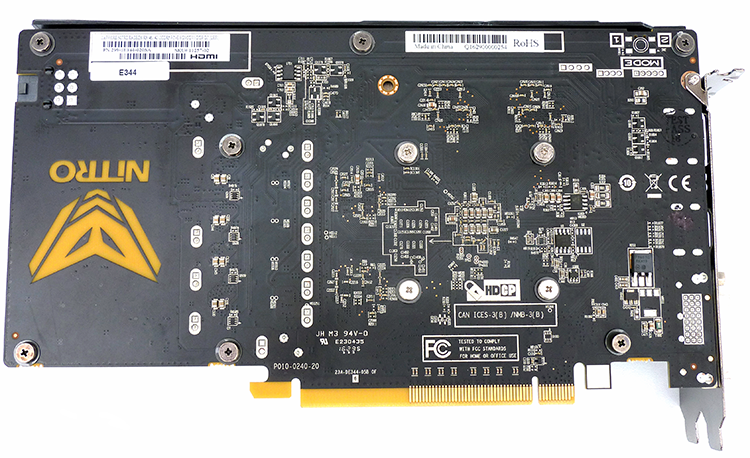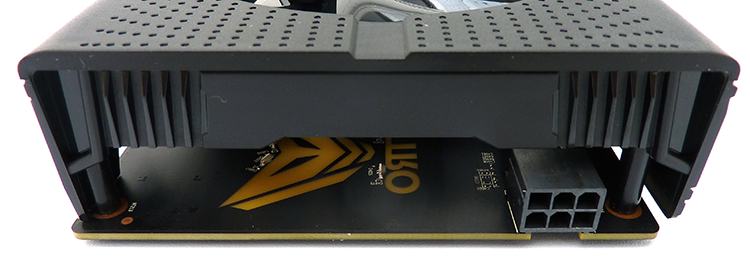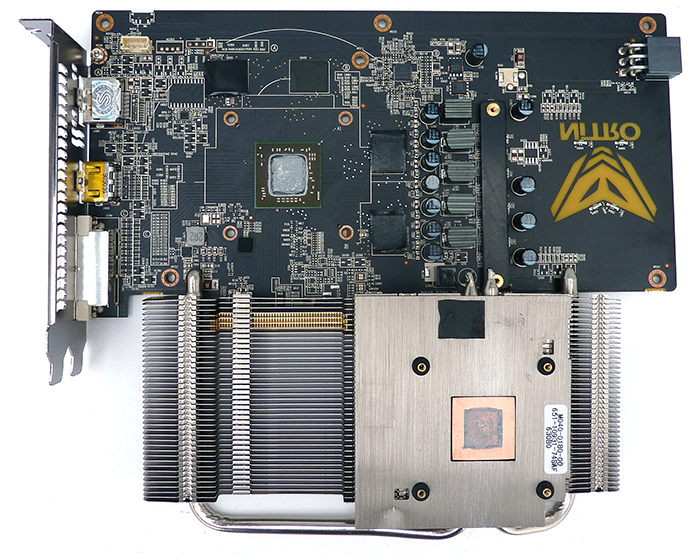Sapphire Radeon RX 460 Nitro 4GB
Sapphire is to retail both 2GB and 4GB models of the RX 460 GPU, priced from £99 and £129, respectively. The larger-than-expected delta between the two has more to do with AMD charging a premium for GPUs used with a larger frame buffer than the intrinsic cost of the extra memory itself, we're reliably informed by an off-the-record chat with an AMD partner.
The familiar design of the new Nitro cooler is in evidence again for the RX 460 GPU. We like the soft-feel finish and high-quality construction, and the twin-fan shroud is, at 220m wide, a shorter version of the more expensive RX 480 GPUs. Differences are subtle, but the RX 460's fan blades are narrower and overall size smaller. They still switch off when GPU temperature is below 52°C.
Notice something strange? Sapphire uses the usual x16 PCIe connector length yet the GPU is electrically connected via a half-width x8.
The plain back is interesting insofar as it shows how much extra PCB real estate Sapphire has to play with. We really see the RX 460 as a mini-ITX solution first and foremost yet do understand that AIBs looking for maximum performance from the mainstream GPU would repurpose older, larger PCBs for it.
This model is bereft of the full-on RGB lighting - controllable by a button on the top-right - available on the premium Polaris GPUs. Instead, Sapphire adds four blue LEDs on the left-hand side as you look at it. The subtle effect gives off a glow on the side of one fan and a green-ish tint through the Nitro logo on the back.
CrossFire support is internal, so no golden fingers per yesterday's generation. Radeon RX 460 supports two-way CrossFireX and general multi-GPU support under DX12.
You can spy a couple of the LEDs in the above picture. An understanding that RX 460 is a mainstream GPU is at odds with the six-pin power connector present here. We hope to see a connector-less version of the 2GB card soon.
The reference spec calls for a peak core speed of 1,200MHz and memory at an effective 7,000MHz. Sapphire increases that to 1,250MHz core but leaves memory untouched. Our logs shows the sample card keeps that rock-solid 1,250MHz core speed throughout our battery of benchmarks.
Mainstream GPUs tend to need a broader range of outputs than premium cards, funnily enough. Catering for a wide number of monitors, dual-link DVI, HDMI and DisplayPort make implicit sense. This cooler is not as enclosed as the RX 470/480 version so less air is expelled out of the back.
Pulling away the heatsink shows the more mainstream bearing of the itty-bitty RX 460 GPU. There's still a copper insert, smaller here, and two heatpipes running through the aluminium fins.
Sapphire does the right thing by adding in thermal tape between the RAM chips and block, while there's a metal strip covering the VRMs on the right-hand side. It's a good, solid design.














